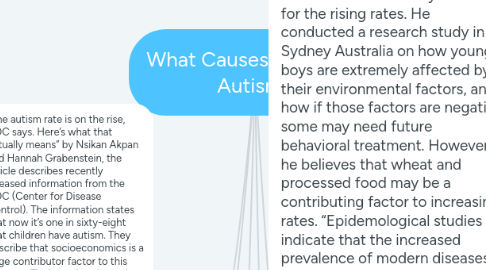What Causes the rise in Autism?
by Caroline newsome

1. “The autism rate is on the rise, CDC says. Here’s what that actually means” by Nsikan Akpan and Hannah Grabenstein, the article describes recently released information from the CDC (Center for Disease Control). The information states that now it’s one in sixty-eight that children have autism. They describe that socioeconomics is a large contributor factor to this increase. Their studies showed at Asian kids are more likely to receive screening than Black and Hispanic people. “In 2012, the ADDM survey detected 20 percent more cases of autism in white versus black children. Compared to Latino children, the gap was even larger, at 50 percent.” (The Autism rate is on the rise, CDC says. Here’s what it actually means.) Now, with more accessible testing Autism prevalence is starting to increase within these minorities thus leading to an increase in Autism prevalence nationwide.
2. What are schools Doing to Help with Students who need accommodations?
3. In “For Children with Autism, No More Being Hushed” by Kate Taylor she covers a program based in New York called “The Nest Program”. In this program a woman named Ms. Siegel, who is a long-time special education teacher is in charge. She has been involved with this program for over 14 years and has helped many children with Autism improve in and out of the classroom.
3.1. Connects with
3.1.1. “Autism and the Inclusion Mandate” by Ann Christy Dybvik. Dybvik describes a boy named Daniel, who is on the spectrum and struggles moving from one task to the next. She then describes how he has a special education assistant sitting and monitoring him in class. The assistant shows him pictures and helps him adjust. Dybvik also discusses a full history timeline on how education has adjusted for students who need extra help, but there is still room for improvement. Dybvik touches on the concept of how each student has very specific needs and how there is no “one and done” solution.
4. Increasing Prevalence, Changes in Diagnostic Criteria, and Nutritional Risk Factors for Autism Spectrum Disorders” by Yasmin H. Neggers. In this article, Neggers addresses the issue of the Autism relevancy and how it is difficult to find the root cause. She then begins to list all of the possible reasons for the increase. One reason being there is no specific Diagnosis criteria, it has been changing since the 1980s. The criteria keeps expanding into different subcategories. There was a significant rise in the relevance of Autism from 1992- 2005. There are also Environmental reasons such as being born premature or very low birth rate that can be relating for the increase. She then goes into detail on how Cultural factors and awareness have greatly contributed to the increase. More specifically saying that, “Celebrities making ASD awareness a cause due to an acquaintance or they themselves having an affected child may have led to increased reporting.” (Neggers) She also agrees with nutrition being a factor with children being born with Autism. She states that taking folic acid will help reduce the likeliness of a children with Autism being born. High doses of Vitamin D may have a factor in the increases rates as well. She is the middle article, that links the two stated before together.
5. “Why the increase in Autism (ASD), ADHD and Neurodevelopmental Disorders?” by Dr. Jacques Duff Psychologist, Clinical Neuroscientist and Nutritionist. Duff brings a different perspective to mind as to why the increased rates. Duff says that environmental and Nutritional factors may to blame for the rising rates. He conducted a research study in Sydney Australia on how young boys are extremely affected by their environmental factors, and how if those factors are negative some may need future behavioral treatment. However, he believes that wheat and processed food may be a contributing factor to increasing rates. “Epidemological studies indicate that the increased prevalence of modern diseases, ASD and ADHD is associated with a western style diet (such as nutrient-poor processed foods, food additives, colourings and preservatives) and environment factors such as lifestyle and pollution.” (Duff)


